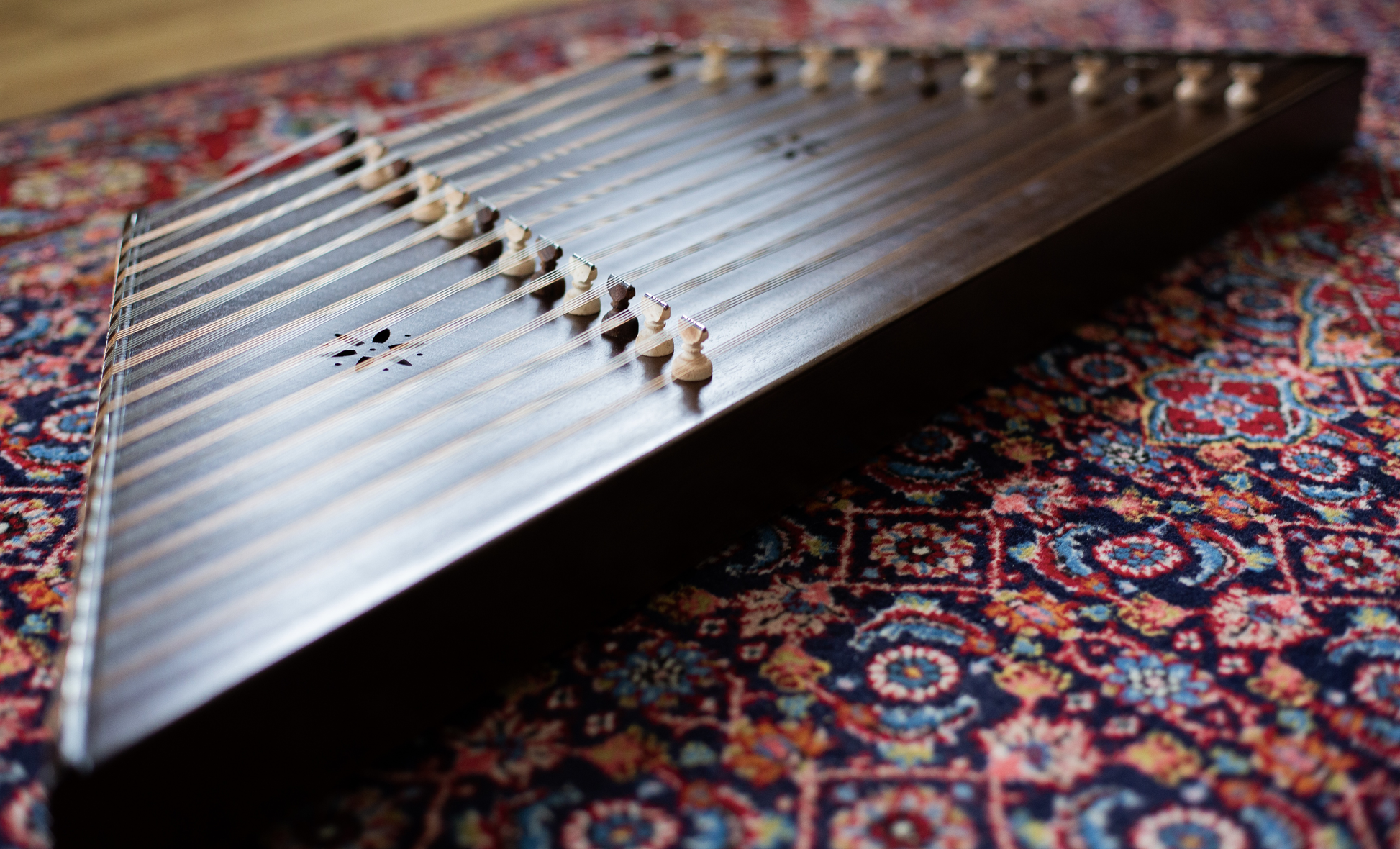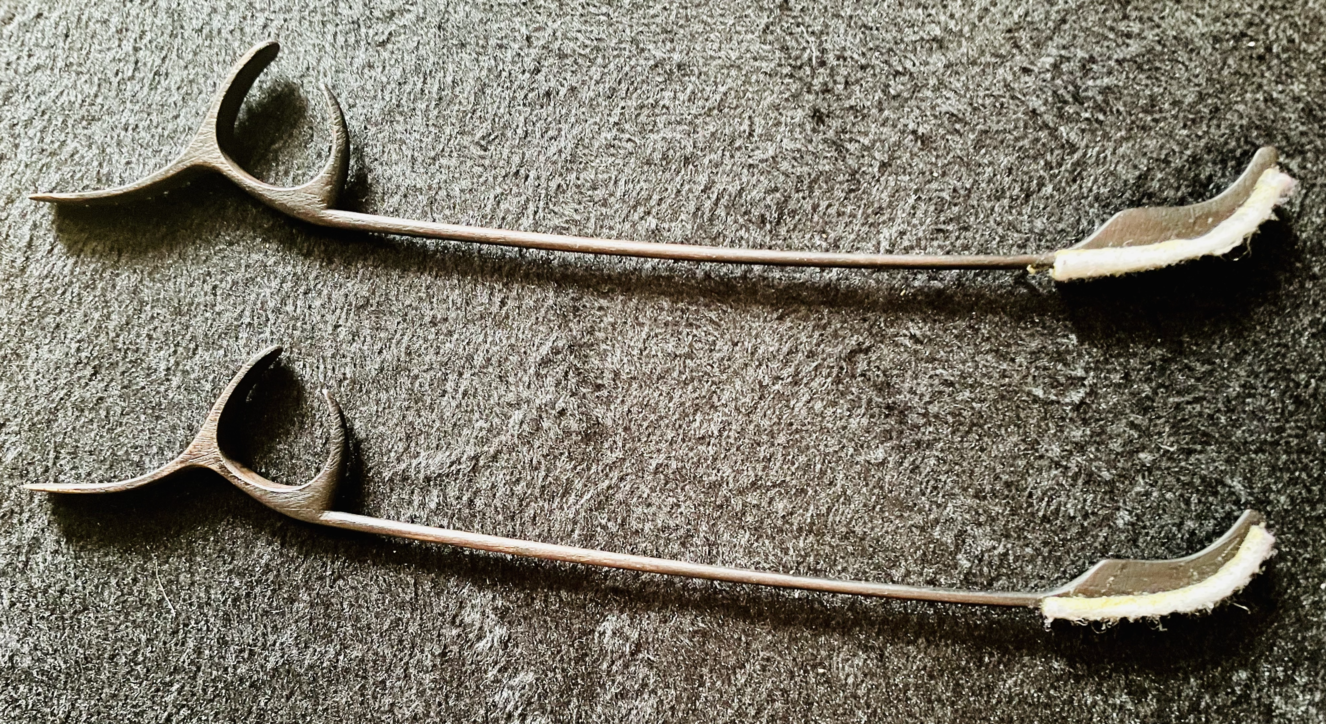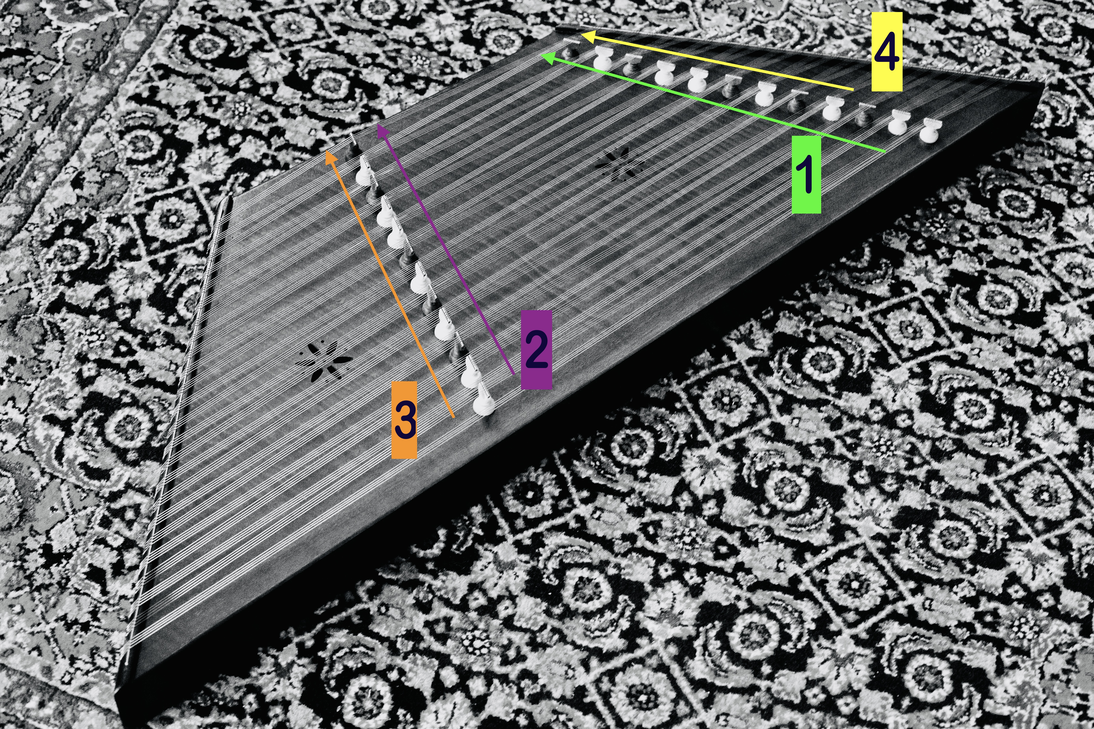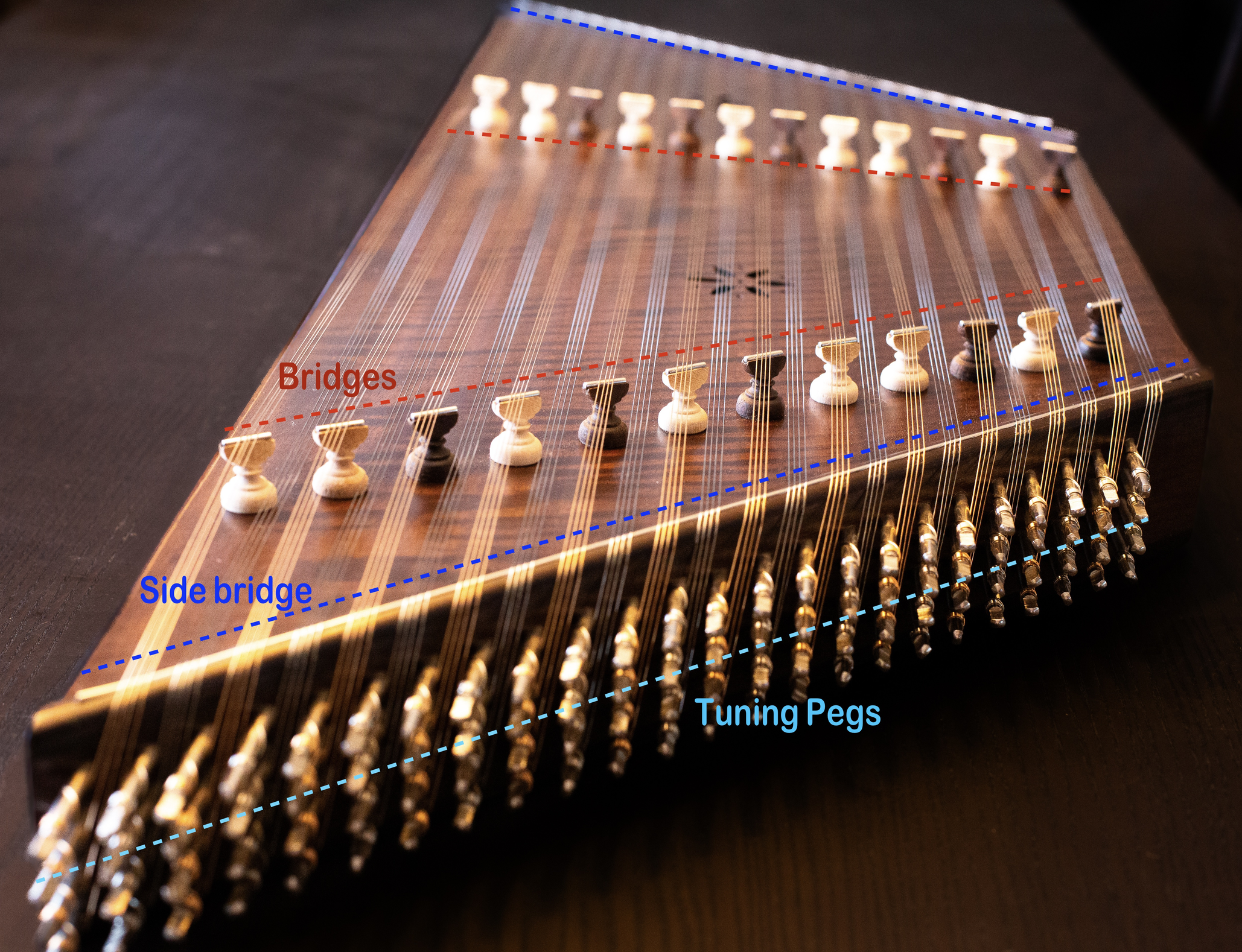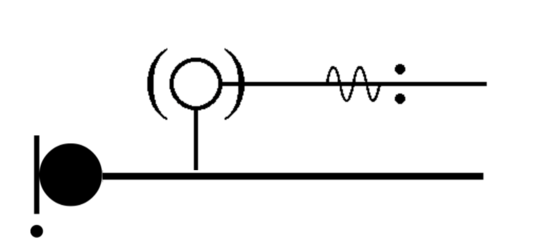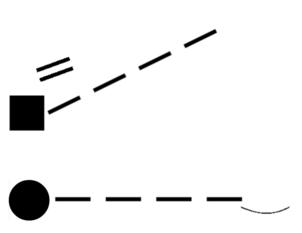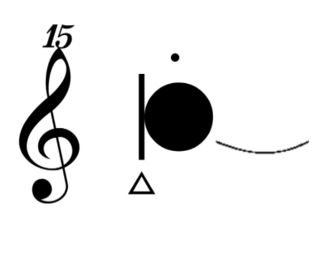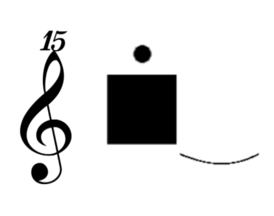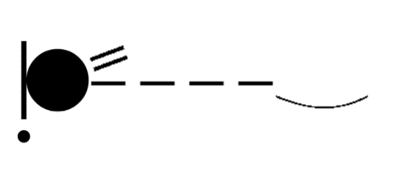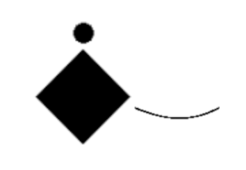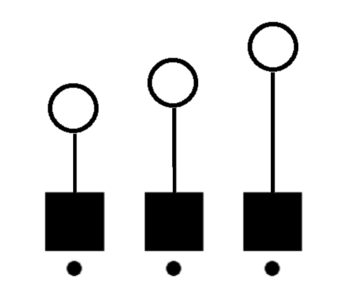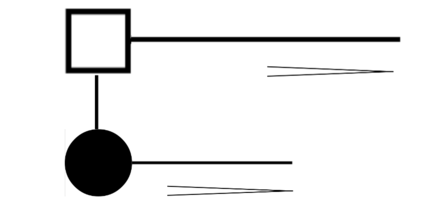The instrument spans three octaves, with some additional notes in the fourth position. These later notes are less common and requiring extra effort to reach. The pictures below illustrates the various positions on the santur, and the pitch of each bridge.
Santur is typically played by striking the strings with two sticks, often featuring cotton-wound tips:
Description of the Santur and its components:
The most prevalent form of santur, known as santur in G, is a rectangular instrument featuring 72 strings. However, this exposition aims to explore another variant known as the chromatic santur. This particular chromatic santur possesses optimal capabilities for integration with Western instruments while maintaining the distinctive sound characteristics of the traditional santur. While sharing similar physical attributes with the traditional santur, the chromatic santur differs significantly in size, the number of strings, and tuning.
In contrast to the ordinary traditional santur, which is limited to have one or maximum two musical scales at the same time, the chromatic santur opens up possibilities for all keys and modulations. However, the chromatic santur lacks the microtones. While it is possible to tune any tone in a microtonal way, it comes at the expense of losing one of the tempered tones. This lack of microtones, together with a different order of tones, contributes to the instrument's rarity in Iran.
Each bridge features a small metal component over which the strings pass, avoiding penetration into the wooden bridge over time. Side bridges are also present on both sides. (Visible in the picture below). Each string is threaded through and around a tuning peg, with the other end having a knot to secure it to a small metal piece on the opposite side.
The playing technique involves two sticks with mallets on top, offering varying degrees of hardness—hard, medium, or soft—based on personal preference.
While different family of santur around the world, bond to a similar structural framework, variations arise in tuning systems, sounds, playing techniques, materials used in the instrument, hammers, and strings. For instance, Cimbalom even has a pedal for damping the strings. I it is evident that a cimbalom player, for instance, cannot seamlessly transition to playing a santur, Indian santur, Yangqin or Tsymbaly, due to these mentioned differences.
In this part I will show various techniques in Santur and highlighting the unique sound characteristics within each. I have incorporated all significant traditional techniques and also explored extended techniques on this instrument. I havn’t seen more than a very few santur players using these extended techniques, and most of these techniques have evolved through my experimentation process.
I should note that my relationship with my main instrument has undergone a transformation since I adopted the spectromorphologic approach. Developed by professor Lasse Thoresen, this approach has played a significant role in broadening my professional life as a Santur player.
I'd like to highlight that the terminology and notation method I've utilized here for describing sound characters follow the approach presented in Professor Lasse Thoresen's book, ‘Emergent Musical Forms’. Here is the web reference link for his book: https://www.auralsonology.com/the-signs/chapter-4-spectromorphology/
7. Hitting on the Wooden Sides of Santur: The musician strikes the wooden part of the instrument with either ahand or a stick.
- Sound Description: The result is again a complex impulse accompanied by a resonance.
- Dynamic Range: The effective dynamic range begins from very P to MF.
On the first and last notes on the Santur, we can incorporate a tremolo technique using the stems of the sticks, applicable to all three positions/octaves on the instrument. This will yield a sound object similar to the same category but with a thinner quality.
- Dynamic range begins from very P to MP.
After playing any technique on the santur, we inevitably encounter its resonance. In general, fully muting the instrument is impossible, as each strike causes other strings to resonate. Upon closer examination of the santur's resonance at a microscopic level, we observe it as a spectral gate. This resonance can be described as an unvoiced, complex sound object with a moderate spectral gate and naturally declining intensity over time.
P.s.: Because of the length and material of the strings, harmonics in the first position are most commonly used on the santur. However, it is also possible to produce harmonics in the second position.
6. Scraping the String on the Metal Part of the Bridge: When the performer uses the end of the stick to scrape one string precisely on top of the metal part of the middle bridge.
- Sound Description: The outcome is a complex impulse that follows by a resonance.
- Dynamic Range: The effective dynamic range begins from PPP to P.
- With this technique, sometimes a clear pitch emerges on top the others, leading this sound object toward a dystonic quality.
In some instances, we can also perceive a distinct pitch within this resonance, which manifests as follows:
(In the audio examples of the next techniques, you will hear the differences of resonances.)
3. Tremolo: One of the most common techniques in Santur, where the player employs both hammers to regularly hit the strings.
- Sound Description: iterated pitched sound object, ending with a resonance.
- Dynamic Range: The dynamic range for this technique spans all levels, providing flexibility for nuanced variations in intensity and volume.
1. Hitting on the peg: The player hits on the peg.
- Sound Description: Complex impulse followed by resonance
- Dynamic Range: The dynamic range begins from very P to something between MP/MF.
4. Striking the Top Metal Part of the Bridge: The player hits the upper metal part of the middle bridge.
- Sound Description: Dystonic impulse with the resonance
- Dynamic Range: The dynamic range for this technique spans all levels, allowing for variations in intensity and volume.
5. Playing with Stem of One Stick Gliding: This technique is only applicable to the first and last notes on the santur. In this approach, the performer moves the striking stick towards the right or left (only one stick). It's only the stem of the stick is utilized to achieve a glissando effect in this technique.
- Sound Description: This will yield two layers of sound objects: pitched iterated sound object alongside complex variable iteration. These will be accompanied by the resonance.
- Depending on the direction of the sticks, it can produce either an ascending or descending complex glide.
- Dynamic Range: The effective dynamic range begins from very P to MP.
1. Single Hit:
The player strikes the target string(s) using either the right or left hammer/stick.
- Sound Description: Begins with a sharp onset and follows by a resonance after that.
- Dynamic Range: The dynamic range for this technique spans all levels, allowing for variations in intensity and volume.
2. Sudden Mute after a Single Hit:
The player strikes the target, usually with the right hand, and promptly mutes it with the other hand. As previously mentioned, even after muting, the resonance persists.
- Sound Description: An impulse-pitched note with sharp onset and sharp ending with resonance.
- Dynamic Range: The dynamic range for this technique encompasses all levels, allowing for variations in intensity and volume.
4. Harmonic:
The player touches the middle of each string to produce the harmonic note, which is an octave higher. While some other harmonics are possible, they require specific practice.
- Sound Description: A complex impulse accompanied by the sustained harmonic tone, and the resonance.
- Dynamic Range: The dynamic range begins from very P to maximum MF.
3. Scraping Shorter Parts of Strings on the Santur: The player holds the end of a stick and scrapes the short part of string between the peg and the right-side bridge, (with a length of less than 5 cm. ).
- Sound Description: The outcome is a very high-pitched impulse, with a brusque onset that followed by a resonance.
A more contemporary variation of this technique involves the player using only the right hammer hitting. Meanwhile, one finger on the left hand touches along the surface of the string, similar act to glissando touch on the violin. The outcome produces a series of harmonics.
2. Tremolo on pegs: Another highly uncommon yet intriguing technique is playing a tremolo on the pegs- (with mallet part of sticks):
- Sound Description: Complex itirated sound object wih the resonance
- Dynamic Range: The dynamic range begins from very P to something between MP/MF.
Scraping the shortest strings in this part, will result in complex impulse sound object with a resonance, (with no specific pitch).
The dynamic range begins from very P to MP.
Similar sound object can arise if the performer slides the end of a stick on a peg, instead of hitting it.
The dynamic range begins from PPP to P.
Similar Complex itirated sound object (wih the resonance) can happen when the performer slides the end of a stick across a series of pegs.
The dynamic range begins from ppp to P.
Both of the aforementioned techniques- Hitting on the peg, and Tremolo on pegs can be performed by wooden part of the sticks. The distinction in the outcome lies in the creation of a thinner yet identical type of sound object.
The chromatic santur has 24 bridges and a total of 96 metal strings. Each set of four strings passes over one bridge, producing a single tone. Consequently, when a player strikes one note, all four strings are hit and vibrated.
As you can see in the pictures below, the first, second, and third positions have the same sequence of notes. However, in the fourth position, we encounter a new order.
Introduction about Santur:
History (by Wikipedia):
The santur was invented and developed in the area of Iran. "The earliest sign of it comes from Assyrian and Babylonian stone carvings (669 B.C.); it shows the instrument being played while hanging from the player's neck. This instrument was traded and traveled to different parts of the Middle East. Musicians modified the original design over the centuries, yielding a wide array of musical scales and tunings. The original santur was likely made with wood and stone and strung with goat intestines. According to Habib Hasan Touma, the Babylonian santur was the ancestor of the harp, the yangqin, the harpsichord, the qanun, the cimbalom, and the hammered dulcimers.
